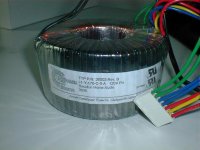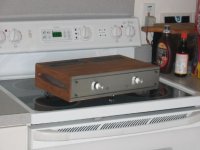joensd said:
Yes, but you can pay with credit card, without paypal-account.
That´s what I meant.
Payments are secure, through paypal. I have never had problems with it, or heard of others having issues.
I am taking money orders if you feel like paypal is inadequate.
--
Brian
Sorry for the confusion.
I think it´s now obvious to me that paypal offers you to make a payment through paypal but without an account (credit card).
Just sent off order. You should have received it by now.
Thank you very much for your effort!
Regards
Jens
I think it´s now obvious to me that paypal offers you to make a payment through paypal but without an account (credit card).
Just sent off order. You should have received it by now.
Thank you very much for your effort!
Regards
Jens
Please correct me if I'm wrong!
I have this transformer I want to use with a gainclone (picture below). Of course I don't want to fry anything. So I hope some one can tell me if I got it right.
The transformers black wires go directly to an outlet. The blue and green pairs measure 21 VAC each. These go to each gainclone channel, right? Is this enough VAC for the gainclone, usually (might be optinion question, I'm not sure)?
Then the red wires have 220 VAC between them and 105 VAC when one is hooked up to the yellow wire. But they do nothing for the gainclone, right?
My last question is about the fuse. It's 2A slow blow right? 5A is too much?
I have this transformer I want to use with a gainclone (picture below). Of course I don't want to fry anything. So I hope some one can tell me if I got it right.
The transformers black wires go directly to an outlet. The blue and green pairs measure 21 VAC each. These go to each gainclone channel, right? Is this enough VAC for the gainclone, usually (might be optinion question, I'm not sure)?
Then the red wires have 220 VAC between them and 105 VAC when one is hooked up to the yellow wire. But they do nothing for the gainclone, right?
My last question is about the fuse. It's 2A slow blow right? 5A is too much?
Attachments
Re: Please correct me if I'm wrong!
Sounds like you have it correct. Make sure to have the slow blow fuse in series with the primary AC hot wire for safety. I am using a 3A slowblo in mine, since I had it laying around.
I would cut off the two red and yellow wires, and insulate the ends, not using them.
The two 21vac secondaries should be just fine for the gainclone. You will put all 4 of these wires into the rectifier pcb, which will power the 2 gainclone channels.
--
Brian
Jimmy154 said:I have this transformer I want to use with a gainclone (picture below). Of course I don't want to fry anything. So I hope some one can tell me if I got it right.
The transformers black wires go directly to an outlet. The blue and green pairs measure 21 VAC each. These go to each gainclone channel, right? Is this enough VAC for the gainclone, usually (might be optinion question, I'm not sure)?
Then the red wires have 220 VAC between them and 105 VAC when one is hooked up to the yellow wire. But they do nothing for the gainclone, right?
My last question is about the fuse. It's 2A slow blow right? 5A is too much?
Sounds like you have it correct. Make sure to have the slow blow fuse in series with the primary AC hot wire for safety. I am using a 3A slowblo in mine, since I had it laying around.
I would cut off the two red and yellow wires, and insulate the ends, not using them.
The two 21vac secondaries should be just fine for the gainclone. You will put all 4 of these wires into the rectifier pcb, which will power the 2 gainclone channels.
--
Brian
Here is a picture of my nearly completed prototype of a 3-way
electronic crossover with 3 of Brian's Gainclones. Although you can see I still have some grounding to complete, I couldn't help but take a quick listen last night and was very encouraged.
I can't thank Brian enough for the effort and hard work he puts forth on behalf of the DIY community. There are obviously some great ideas promoted by some very talented people on this site.
Thanks to all of you.
BobK
electronic crossover with 3 of Brian's Gainclones. Although you can see I still have some grounding to complete, I couldn't help but take a quick listen last night and was very encouraged.
I can't thank Brian enough for the effort and hard work he puts forth on behalf of the DIY community. There are obviously some great ideas promoted by some very talented people on this site.
Thanks to all of you.
BobK
Attachments
finding metal box?
Hey BobK Where did you get a metal box like that?
or Anyone know a site that sell metal box that is thin enough for easy drilling?
Hey BobK Where did you get a metal box like that?
or Anyone know a site that sell metal box that is thin enough for easy drilling?
SS1, the box I used is made by LMB, but Bud and Hammond make similar boxes. They drill and file very easily but are very light-weight. I mainly use them for proto work. Mouser is a good mail order source, my 3x8x12 ran about $28.
BobK
BobK
There seem to be a lot of choices in Grayhill switches, and that brings up a couple questions. Do you switch both the imput and the ground? Could you suggest a Grayhill that might be the "perfect?" selection for a three input selector switch?
Ok, I experienced my first Cap explosion. Luckyly, I read the safety thread on anything else forum thius morning before this happen. I weared google, gloves, head and ready for anythign happen. The reason why it explose is due to my carelessness of opening a liquid like heatsink compound which spoiled some on one cap. So I desolidered it and clean it. However, I still un sure about the problem, did I solved it? Then I know the problem didn't sloved by using napkin. So how can I clean all these cap liquid from the explosion, and the heat sink compound? and how can I check the status of the components by a meterin order to determine which components had failed?
addition: How can I determine the + side of the cap after I striped down the rubber cover?

addition: How can I determine the + side of the cap after I striped down the rubber cover?
S.C said:...how can I check the status of the components by a meterin order to determine which components had failed?
addition: How can I determine the + side of the cap after I striped down the rubber cover?
I would recommend using your meter to check more than just the components. Check to make sure there is no short between the cap leads or between the + cap lead and ground or any other component.
I wouldn't remove the plastic insulation, it only makes it more susceptible to problems. But if you have removed the insulation but you haven't yet cut the leads then the + lead is longer.
Sherman said:I wouldn't remove the plastic insulation, it only makes it more susceptible to problems. But if you have removed the insulation but you haven't yet cut the leads then the + lead is longer.
The problem is I have already reomoved the plastic and cut the lead. So what should I do?
You said I need to check are there any short around, but how about the liquid spoil all over the board, do I need to clean it first with special solutions or just use a paper towel whip it? And what reading I am looking for when I test the caps, resistors, and the diodes with a meter?
I am talking about the liquid of Heat Sink Compound (Type Z9 Silicon, and the liquid from cap explosion.Peter Daniel said:What kind of spilled liquid are you talking about?
I don't think those are conductive really. Just wipe it off with a rug and some cleaner (I usually use Varsol, paint thinner for such purposes).
Why did the cap explode?
Why did the cap explode?
There are probably 2 reasons:
1. The Heat Sink components spoiled on it and I hadn't cleaned it throughly even though I had already desoldiered it and clean it with paper towel. (can I use Isopropyl Rubbbing Alcohol to clean it?) I also checked the conductivity, and I also get no beep sound from my meter too, so I am now suspecting the second reason
2. The cap leads on wrond side.
1. The Heat Sink components spoiled on it and I hadn't cleaned it throughly even though I had already desoldiered it and clean it with paper towel. (can I use Isopropyl Rubbbing Alcohol to clean it?) I also checked the conductivity, and I also get no beep sound from my meter too, so I am now suspecting the second reason
2. The cap leads on wrond side.
Sherman said:Depending on the liquid you could just wipe it off with a paper towel but some are more stubborn than others, especially anything with sugar in it (soft drinks, coffee, tea). I generally clean my boards with alcohol and a paper towel, sometimes using a Q-Tip in small areas where a paper towel won't work. That gets rid of everything including solder flux.
I'm just stupid. So is the alocohol I metioned just before your post will sutable for this case? It is 99% Isopropyl Rubbing Alcohol, and it is flamable. Will it burn if things spike? Will the alcohol react with the liquid over the board and components?
Do I need to buy other alcohol? I just want to play it save now, and a little bit cirious.
If you want to remove jackets, the recommended way is to do it after the part is installed and the circuit tested. I would rather suspect the reason for explosion mounting the caps with wrong polarity. Heatsink compound shouldn't be conductive. You can use alcohol without problem.
S.C said:
I'm just stupid. So is the alocohol I metioned just before your post will sutable for this case? It is 99% Isopropyl Rubbing Alcohol, and it is flamable. Will it burn if things spike? Will the alcohol react with the liquid over the board and components?
Do I need to buy other alcohol? I just want to play it save now, and a little bit cirious.
The 99% isopropyl will be fine. Just disconnect all power to the board and make sure any caps still on it are discharged before cleaning. You can use a high wattage resistor (I've been using a 100K 1/2 watt flame-proof resistor) to discharge the caps. Also don't smoke or do the cleaning by candlelight!
S.C said:
I'm just stupid. So is the alocohol I metioned just before your post will sutable for this case? It is 99% Isopropyl Rubbing Alcohol, and it is flamable. Will it burn if things spike? Will the alcohol react with the liquid over the board and components?
Do I need to buy other alcohol? I just want to play it save now, and a little bit cirious.
I use Isopropyl Alcohol and somtimes Hydrogen Peroxide, no smoking while you use these chemical!!
- Status
- Not open for further replies.
- Home
- Amplifiers
- Chip Amps
- Gainclone building thread based on BrianGT's boards


